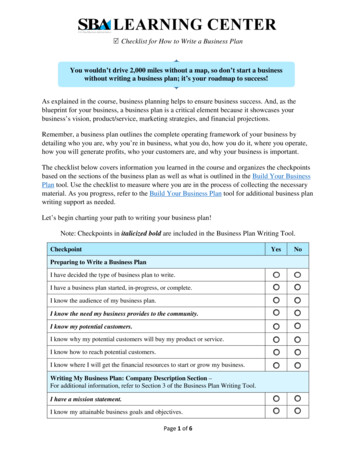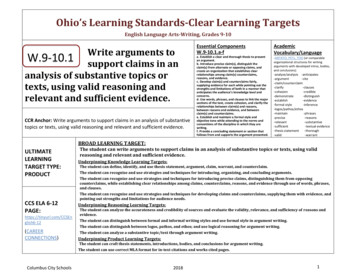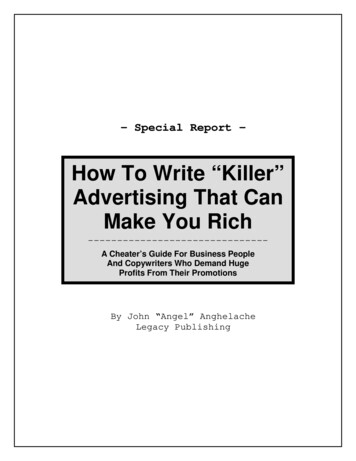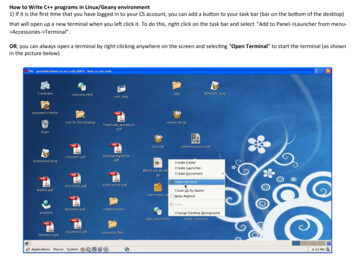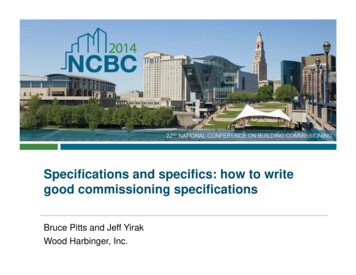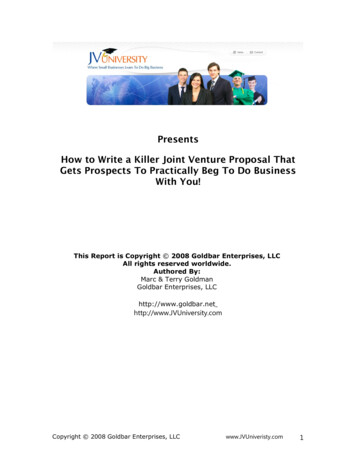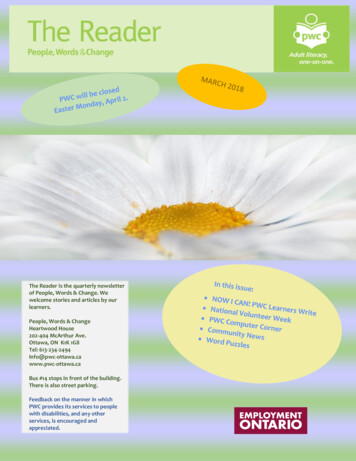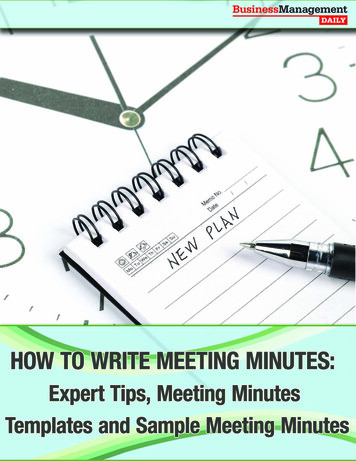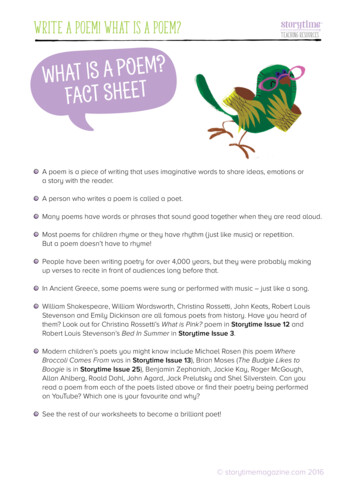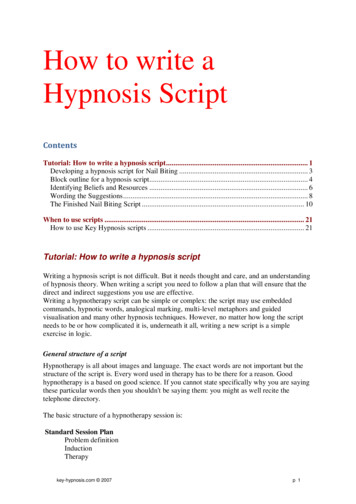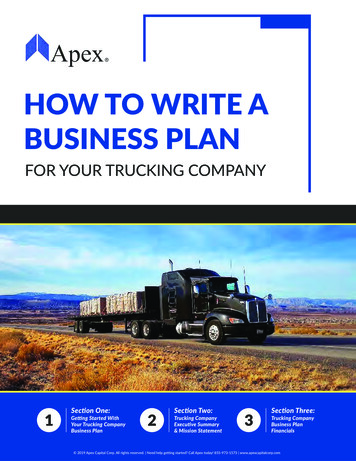
Transcription
HOW TO WRITE ABUSINESS PLANFOR YOUR TRUCKING COMPANYSection One:Getting Started WithYour Trucking CompanyBusiness PlanSection Two:Trucking CompanyExecutive Summary& Mission StatementSection Three:Trucking CompanyBusiness PlanFinancials 2019 Apex Capital Corp. All rights reserved. Need help getting started? Call Apex today! 855-973-1573 www.apexcapitalcorp.com
TABLE OF CONTENTSHOW TO WRITE A BUSINESS PLAN FOR YOUR TRUCKING COMPANYWhitepaper Intro1Section One2Section Two5Section Three6BUSINESS PLAN QUESTIONNAIREQuestionnaire Template10BUSINESS PLAN QUESTIONNAIRE EXAMPLEQuestionnaire Example12BUSINESS PLAN EXECUTIVE SUMMARYExecutive Summary14Exhibit A20Exhibit B21
1How to Write a Business Plan for Your Trucking CompanyHave you always wanted to own a trucking company and become your own boss, but you don'tknow the first thing about starting a business? We can help you! We’ll explain the elementscommonly found in a traditional business plan, give examples to help complete it, and take a deepdive into planning for your trucking company’s finances.YOU MIGHT BE ASKING YOURSELF:Why do I need a business plan?A business plan is vital for long-term success. According to Avondale Partners, only 15% ofnewly formed trucking companies make it to their second year of operation. But creating abusiness plan helps you pinpoint potential pitfalls before they happen. There are many stepsinvolved with running a trucking company and it canbe challenging to keep trackof them all. Writing out abusiness plan puts yourthoughts to paper so thatyou can revisit, revise, andre-evaluate them later.A BUSINESS PLAN IS VITALFOR LONG-TERM SUCCESS.What is a business plan?A business plan is exactly what it sounds like, it’s a plan for your business's future. It's a way to thinkthrough how you want to run your business and come up with strategies for how to be successful.How do I begin writing my trucking company’s business plan?Great question! Now that you know why creating a business plan is important, you can start writingyours. But where do you start? It’s important to think through or even brainstorm these businesscomponents first.1What types of services will you provide?7What do you know about your competitors?2Who will you hire?8What are your main goals?3What products/services will you need?9What is your short-term growth plan?4What will be your competitive edge?10What is your long-term growth plan?5What does your industry sector look like?11What will your expenses be?6Where will you find customers?12Think about your revenue.What will it take to make a profit?
2SECTION ONEGetting Started with Your Trucking Company Business PlanWe’ve included a Business Plan Questionnaire template (page 10). Please follow along answeringeach of these brainstorming questions as we go through them below.What types of services will you provide?Before you start your trucking company, you need to decide what types of services your truckingcompany will provide. Will you haul freight interstate or intrastate? Will you run long haul,over-the-road, or stay in a specific geographic region? Think about what freight types you want tohaul and the equipment needed to haul them. Will you be hauling truck-load (TL) orless-than-truckload (LTL)?Who will you hire?When you start your trucking company, will it be just you, your truck, and a dream running as anowner-operator? Or do you plan on hiring a driver? Will you have someone to help you withback-office support or provide dispatching services? Determining staffing needs ahead of time isimportant as it can be a major business expense.What products/serviceswill you need?If your trucking company is going to run its owntruck, do you plan on financing your truck? If so,you’ll need to find an equipment financingcompany. You’ll also need insurance, an electroniclogging device (ELD), and a drug and alcoholtesting provider. You might also need help forcompliance with the Federal Motor Carrier SafetyAdministration (FMCSA). In addition to theseproducts and services, you might want to use afactoring company or fuel card provider.Familiarize yourself with various products andservice providers. We suggest that you get pricequotes and read reviews beforehand to help youdecide who you want to work with.FACTORING & FUELFreight factoring is all about cash flow. Cash flowkeeps a trucking company in business. It’s abouthaving funds for fuel, payroll, repairs, and more.Freight factoring is an easy way to manage cash flowfor your trucking company. We buy invoices forfreight you’ve already delivered. It’s money that isadvanced on accounts receivable. Freight factoringkeeps the cash flowing so you can keep hauling.www.apexcapitalcorp.com/factoring/Diesel fuel costs can take up a big portion of yourtrucking company’s operating expenses. The ApexFuel Card Program, with help from our fuel cardpartner TransConnect Services (TCS), is acomprehensive fuel card for trucking companies largeor small. Apex clients save an average of 30 cents pergallon with zero transaction fees at in-network fuellocations nationwide.www.apexcapitalcorp.com/fuel/
3What will your competitive edge be?Newly formed owner-operators can all look the same, but you need to think about what will giveyou an advantage over your competition. Do you have industry experience proving that you’re areliable and dedicated employee? If you have driving experience, did you operate safely andmaintain a good safety record? Use any good references, referrals, or connections to youradvantage to find customers and build up a good reputation.Where will you find customers?Some trucking company owners have pre-existingrelationships with brokers and shippers and use theirconnections to find business. But most newly formed truckingcompanies don’t know where to start or how to find loads.Many trucking companies use load boards. They’re a greatplace to find freight in the spot-market.NEXTLOADNextLOAD is a product of Apexand is a 100% FREE load board fortruckers to find freight when theyneed it. What are you waiting for?Create your free account today!www.nextload.comBUILD A FLEET.LEAVE A LEGACY.ACHIEVE RETIREMENT.What are your main goals?Why do you want to start your own trucking company and become your own boss? Do you wantto be an owner-operator and get to travel across the country? Do you want to eventually build afleet and leave behind a legacy for your family? Or do you want to use this business to achieveyour retirement goals? Whatever the reason, make sure that you keep it in mind so that thedecisions you make align with those goals.
4What is your short-term growth plan?Growing your trucking company in just one or two yearsis possible, just be sure to put some strategies in placebeforehand. We suggest you calculate your break-evenpoint, which helps you understand what freight rates tolook for and which loads to haul. You want to make sureBreak-even point (BEP) - thethe work you’re doing is making your trucking companypoint at which the total costsa profit. We will go over how to calculate yourand total revenue are equal.break-even point in more detail in section three of thisThere is no loss but also no gain.guide. A big part of growing a trucking company ismaintaining steady and reliable cash flow. That can bedone through factoring your freight bills and using a fuel card to purchase fuel.You can also commit to looking for other ways to cut costs or reduce your monthly expenses.BREAK-EVENPOINTWhat is your long-term growth plan?Planning for growth in the future is important. Think about if you want to eventually add trucks ordrivers. If you do, you’ll have to think about what else comes with that type of growth, things likehigher maintenance and payroll costs. Some successful business owners will take a portion of theirprofits and use it to reinvest back into their company. Saving money for a rainy day helps withunexpected expenses, like maintenance, repairs, and potential cargo claims.TYPES OF EXPENSES1Formation Expenses2Monthly Operating Expenses3Annual Expenses4Other One-Time ExpensesWhat will your expenses be?Have you ever heard the expression, “you have tospend money to make money”? In the truckingindustry that’s especially true because you don’t getpaid until after your job is finished. But you’ll haveexpenses before your job is finished! Fuel, insurance,and equipment are just a few of the commonexpenses trucking companies have. We will go intomore detail about trucking company expenses insection three of this guide.What will it take to make a profit?Making a profit can be simplified by this calculation, REVENUE - EXPENSES PROFITIn order to make a profit you need to project your revenue and expenses. We’ve includedinstructions to calculate your break-even point and set up an income statement projectionlater in this guide. Both of those projections will help you build a profitable trucking company.
5SECTION TWOTRUCKING COMPANYEXECUTIVE SUMMARY& MISSION STATEMENTWe’ve included the Business Plan Executive Summary (page 14) template in this guide. Followalong and complete each field using your answers on the Business Plan Questionnaire (page 10)as a starting point.Now that you’ve thought through how your trucking company willoperate, plan for growth, and achieve a profit you’re ready for theBusiness Plan Executive Summary included in your guide. It really isthat simple! There is one essential part of the business plan that isoften overlooked.Believe it or not developing a mission statement is very importantwhen starting a business. Why? Because it serves as a guide for all thecompany’s future decision-making. It’s important to refer to your missionstatement to make sure your future business decisions align with your original intentions for yourtrucking company. That doesn’t mean that your mission statement needs to be complicated oreloquent. Mission statements should be simple.MISSION STATEMENT TIPS:Stick toOne SentenceAim for Under12 WordsBe SpecificMission Statement Example: Our company is dedicated to safely and efficiently deliveringgoods to America.
6SECTION THREETrucking Company Business Plan FinancialsIn the Business Plan Executive Summary (page 14) template, we’ve included Exhibit A and B. Pleasefollow along and fill out each portion as we go through them below.The next step in developing your business plan is figuring out your trucking company’s finances.This can be projected with an income statement and a break-even analysis.Income Statement ProjectionAn income statement, also called a profit andloss (P&L) statement, is the one way todetermine your business’s net income. It’s acomprehensive way to plan for your truckingcompany’s profit that subtracts expenses fromrevenue. Income statements are usuallycompleted monthly, quarterly, and annually.When projecting an income statement, you willcreate an estimate of how much you think yourrevenue and expenses will be – letting you knowyour projected net income, too. We’ve includedan income statement projection for you tocomplete in this whitepaper.DEFINITIONS:EXPENSES: The costs of operating a trucking company.INCOME STATEMENT: Also known as Profit and Loss (P & L) Statement — a financial reportthat lists out your revenue and expenses during a particular period.NET INCOME: The amount of money that is left after expenses are taken out.REVENUE: The income you receive or the checks that you cash from your customers.
7How do you come up with your estimated revenue andexpenses? We suggest doing some research and talking topeople who’ve been through it.WHEN THINKING ABOUT EXPENSES YOU’LL COME ACROSSTWO DIFFERENT TYPES –VARIABLE AND FIXED.Fixed Costs:Variable Costs:VARIABLE VSFIXED COSTSCOSTSThese are expenses that consistently occur,regardless of how many loads you deliver.Examples include monthly truck payments,monthly insurance payments, andadministrative payroll. Annually, you willneed to pay for permits or license renewals.These payments are generally the sameevery pay term so budgeting for these typesof expenses can be simple.VARIABLEFIXEDThese are expenses that are connected toMONTHShow often your company hauls loads. Theseexpenses include fuel, maintenance andrepairs, meals, and lodging. After all, youcan’t make money in the trucking industry without spending some, too! Variable costs can be harderto anticipate when compared to fixed costs. After operating a few months, you should have a betteridea of your variable costs.For more information about the costs of starting a trucking company, read ourarticle at ucking-company
8Break-Even PointOnce you have an estimated expense total you can use it to determine your break-even point. Yourbreak-even point tells you how much your trucking company needs to generate in revenue to coverall your expenses. Simply, what your trucking company needs to break even, not making a profit oroperating at a loss. It might seem inefficient to calculate what your trucking company needs tobreak even, but it’s a great tool to help you determine how much revenue you need to make inorder to be profitable.Fill out your direct and indirect expenses inExhibit B of the Business Plan ExecutiveSummary (page 21) and you will be able todetermine your break-even revenue.The next projection you’ll want to know isyour target rate-per-mile. Your targetrate-per-mile is an estimate of how muchrevenue you want to earn per-mile. Knowingyour target rate-per-mile helps you identifywhich loads to haul and the rates that willbring your trucking company a profit.To find your target rate-per-mile you’llestimate your desired monthly profits anddivide that by the number of miles you’ll drivein a month.DIRECT & INDIRECTEXPENSESDIRECT EXPENSES: The costs thatcome from operating a truckingcompany that relate to the productionof a good or provision of a service. Anexample of a direct expense for yourtrucking company would be fuel andpayroll.INDIRECT EXPENSES: The costs thatcome from operating a truckingcompany but are not directly related toa product or service. An example of anindirect expense for your truckingcompany would be office expenses andbusiness permits.DETERMINING YOUR DESIRED MONTHLY PROFITS:Use your break-even point to help you find your desired monthly profits. We suggest youstart with 10-15% above your break-even point.
9WHAT’S NEXT?Getting Started with Your Trucking Company Business PlanIf you’ve followed along with us, filling out both templates – congratulations! You should have acompleted business plan for your trucking company. But what’s next? The next step is for you tomove forward with starting your trucking company. We can help! The Apex Startup Programhelps you with the formation filings and registrations for your trucking company. Using a startupcompany provides you with more time and resources to plan for other business needs, such asgetting equipment, insurance, an ELD, potential employees, and more.If you’re worried about operational cash flow after starting your trucking company, we can helpwith that, too! Factoring your freight bills is the best way to get cash fast so that you cananticipate and budget for expenses.Watch our How to Write a Business Plan video series:Part One: https://youtu.be/h MvqjNfCMEPart Two: https://youtu.be/8hYUPhbQJroWhen You're Ready To Start YourTrucking Company, Give Us A ss-plan
10BUSINESS PLANQUESTIONNAIREBusiness Planning ToolsWhat types of services will you provide?Who will you need to hire?What products/services will you need?What will be your competitive edge?What does your industry sector look like?Where will you find customers?What do you know about your competitors?What are your main goals?
11What is your short-term growth plan?What is your long-term growth plan?What will your expenses be?ExpensesCostFormation Insurance IFTA Equipment Fuel Monthly Service Subscriptions Other Think about your revenue. What will it take to make a profit?
12BUSINESS PLAN QUESTIONNAIRE EXAMPLEBusiness Planning ToolsWhat types of services will you provide? Long haul, over-the-road, freighttransport services Specific equipment or freight types: reefer, dryvan, heavy haul, expedited freight, etc. Truck load or less than truckloadWhat products/services will you need? Equipment finance companyInsurance companyELD providerFactoring companyFuel card providerWhat does your industry sector look like? Interstate/Intrastate Over-the-road Spot marketWhat do you know about your competitors? Experienced drivers or staff Variety of equipment types for all typesof freight Name recognitionWho will you need to hire? Owner-Operator (not hiring) Driver(s) Back office supportWhat will be your competitive edge? Industry experience, reliable, and dedicated Great reputation with referrals from pastcustomers/employees Good safety scoresWhere will you find customers? Load boards for spot-market freight Pre-existing relationships Dispatch servicesWhat are your main goals? Buy more trucks or trailers Leave a legacy for my family Build a retirement plan
13What is your short-term growth plan? Find areas to cut costs Find the break-even point Own or lease equipmentWhat is your long-term growth plan? Add trucks and drivers Use a portion of profits to reinvest back intothe businessWhat will your expenses be?ExpensesCostFormation Insurance IFTA Equipment Fuel Monthly Service Subscriptions Other Think about your revenue. What will it take to make a profit? I need revenue that is 10 - 20% over my break-even point.
14Be clear in describing your business, the services it will provide, your ideal customers, and your businessgoals. It’s best to complete this sec on last a er you have gone through the details you want in theother categories.Company Name:Services Provided:Examples: general freight transportation or specialized/hazardous material transportation; interstate orintrastate freight transporting services; long haul or short haul transportation; truck load or less thantruckload freight services; etc.Company Goals:Examples: operate 2 to 3 trucks within 2 years with 5 dedicated customers; be my own boss and createmy own schedule while operating a profitable company; create a profitable legacy for my family; etc.
15Company Descrip onDefine your business model by iden fying key personnel, details about services offered, differen a ngquali es, as well as a mission statement.Mission StatementMission Statement:Examples: our company believes in providing efficient, professional services in a safe way; etc.Key Personnel and their Roles:Examples: owners, managers, drivers, administrative roles, contractors, etc.; specifically identify theseindividuals as yourself, family members, employees, etc.Differen a ng Quali es of Services:Examples: safety, reliability, efficiency, experience, industry knowledge, customer service, value addedservices, etc.
16Company StrategyDescribe your industry, customers, and strategic partners while giving a compe ve, regulatory, andgrowth analysis.Industry Descrip on:Examples: interstate long-haul general freight transportation in the 48 continental United States;intrastate aggregate truckload transportation within specific region of specific state; etc.Customer Descrip on:Examples: brokers and/or shippers; large companies or small companies; customers found in the spotmarket or load boards; dedicated freight from specific customers or connections; industry specificcustomers; etc.Compe tor Descrip on:Examples: other freight transportation companies similar to mine; larger or smaller companies;companies that are more or less established; companies with more or less experience; companies withmore or less industry knowledge; companies with more or less backup support; etc.
17Strategic Partners:Examples: factoring company, fuel card company, specific customers, etc.Compe ve Advantage:Examples: safety, reliability, efficiency, timeliness, loyalty, etc.Applicable Regula on:Examples: Fede
factoring company or fuel card provider. Familiarize yourself with various products and service providers. We suggest that you get price . trucking company’s operating expenses. The Apex Fuel Card Program, with help from our fuel card partner TransConnect Services (TCS), is a
